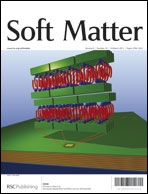The reentrant volume phase transition of cross-linked poly(N-isopropylacrylamide) gels in mixed water/methanol solvents is shown to be induced by the competition between polymer–water hydrogen bonds and polymer–methanol hydrogen bonds by means of the theoretical analysis of the experimental data. On the basis of a statistical-mechanical model for the competitive hydrogen bonds with cooperativity in forming sequences of hydrogen bonds on a polymer chain, the swelling ratio Q, the degree of hydration θw, the degree of methanol binding θm, the total coverage ![[small theta, Greek, tilde]](https://www.rsc.org/images/entities/i_char_e123.gif) of polymer chains by the bound solvent molecules, the excess (selective) adsorption ΔξE of methanol, the spinodal region, are theoretically calculated as functions of temperature and the volume fraction ξ of methanol outside the gel. The results are compared with the experimental data. At room temperature T = 26.1 °C, the gel exhibits a discontinuous collapse (Q ≈ 0.15) at ξ ≈ 0.18 by the cooperative dehydration of the polymer chains. For higher ξ, the gel approaches the swollen state (Q ≈ 1.5), while in other temperature regions the coverage
of polymer chains by the bound solvent molecules, the excess (selective) adsorption ΔξE of methanol, the spinodal region, are theoretically calculated as functions of temperature and the volume fraction ξ of methanol outside the gel. The results are compared with the experimental data. At room temperature T = 26.1 °C, the gel exhibits a discontinuous collapse (Q ≈ 0.15) at ξ ≈ 0.18 by the cooperative dehydration of the polymer chains. For higher ξ, the gel approaches the swollen state (Q ≈ 1.5), while in other temperature regions the coverage ![[small theta, Greek, tilde]](https://www.rsc.org/images/entities/i_char_e123.gif) changes continuously.
changes continuously.

You have access to this article
 Please wait while we load your content...
Something went wrong. Try again?
Please wait while we load your content...
Something went wrong. Try again?
![[small theta, Greek, tilde]](https://www.rsc.org/images/entities/i_char_e123.gif) of polymer chains by the bound
of polymer chains by the bound ![[small theta, Greek, tilde]](https://www.rsc.org/images/entities/i_char_e123.gif) changes continuously.
changes continuously.

 Please wait while we load your content...
Please wait while we load your content...